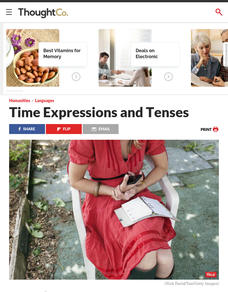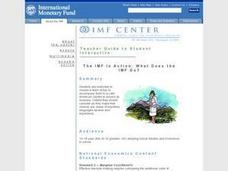Curated OER
That Sneaky E!!
Introduce your class to the concept of vowel digraphs. They identify the digraph /ea/ in spoken language. After a brief discussion, they apply the rule for identifying and spelling words containing the /ea/ digraph. Because the...
Curated OER
Jambo Means Hello: An Introduction To Swahili
Students gain an appreciation for Swahili as a language spoken in many parts of Africa. They share and illustrate words from their own culture using English and Swahili and others to create a word quilt.
Curated OER
Beginning and Ending Sounds
First graders practice their letter and word recognition skills. In this initial and final sounds lesson, 1st graders participate in a classroom activity that requires them to blend phonemes into spoken words and sound out multisyllable...
Curated OER
Negative Imperatives and Idioms
Students identify and use positive and negative imperatives and idioms in written and spoken dialogues, and use irregular verbs in written and spoken sentences. They complete various worksheets, re-write dialogues, and complete an...
Curated OER
Language Arts: Phonemes and Short Vowels
Young scholars identify the short u vowel sound and recognize phonemes in spoken words. By orally practicing tongue twisters, they recognize how to pronounce the sounds. In a written assessment, students examine pictures, name the...
Curated OER
Chinese Opera
Students study Chinese opera by sketching pictures of Chinese opera characters and musical instruments. They watch the film A Night at the Peking Opera, noting the elaborate costuming, the sparse staging, and the highly developed use of...
Curated OER
Foreign Language Initial Reading
Students match sentences and phrases to pictures in a target language. They identify the proper written form of familiar spoken phrases. Students practice labeling objects and pictures with the proper greeting, color, number or object...
Curated OER
PICTURE ID
Students name or label some pictures of important people and events from areas where the target language is spoken. They study prominent people in history and identify individual pictures of prominent people from the target culture(s)....
Curated OER
Tell Me A Foreign Language Story
Students practice retelling a simple story representative of the country where the target language is spoken: French, German, or Spanish. Given a worksheet with story details, students fill in missing details and rearrange details to...
Curated OER
Buh Bee and Duh Dee
Learners differentiate between /b/ and /d/ in both written and spoken words. They listen to the /buh/ and /duh/ sounds in words, a tongue twister, and in Audrey Wood's, Silly Sally. They recite the tongue twister before writing /b/ and...
Curated OER
The Scary, Creaky Door
Students recognize the short vowel e in written and spoken language. Through listening and matching activities, they discriminate the vowel sound /e/ from other phonemes. Students identify the phoneme and letter in pictures using a...
Curated OER
Shirley Loves To Shake Her Shakers
Students identify the digraph /sh/ in written and spoken language. After a brief discussion of the independent and combined sounds of the phonemes /s/ and /h/ students practice identifying initial and final placement of the new digraph...
Curated OER
Ow! That Hurts
Students study the ou=/ow/ correspondence in written and spoken words using a tongue twisters and a letterbox lesson. They recite the tongue twister and make given words using the letterboxes. Next, they listen to a read aloud of Audrey...
Curated OER
It's Time to Open Wide for O
Students recognize the short vowel o in written and spoken language. Through listening and decoding activities, they discriminate the vowel sound /o/ from other phonemes. Students match the phoneme and letter in words they read on index...
Curated OER
Perfectly Popping
Students identify p in spoken words and the written letter the represents it. The story, Hop on Pop by Dr. Seuss is read the the class. They then have to circle pictures that have the p sound in them. This assessment is done after...
Curated OER
Marvelous Muffins!
Students study the letter "m" in written and spoken words by making the sound, reciting a tongue twister, and writing the letter. They identify the sound in words and in Laura Joffe Numeroff's book, "If You Give a Moose a Muffin". Next,...
Curated OER
Here Kitty, Kitty
Students recognize the short vowel i in written and spoken language. Through matching activities, they discriminate the short vowel /i/ from other vowel sounds. Students associate the phoneme with its letter representation and identify...
Curated OER
Subjects, Objects, and Gerunds
Students identify gerunds in written and spoken form. They analyze sentences for subjects, verbs, and objects. They complete a Gerund Practice worksheet independently, exchange papers and correct. They work in pairs to complete other...
Curated OER
Use of Time Expressions
Students improve their written and spoken accuracy by having a good grasp of the relationship between time expressions. After a lecture/demo, students work individually to complete an assignment imbedded in this plan.
Curated OER
Pronunciation: Practicing Stress and Intonation
Students improved pronunciation by focusing on the stress-time nature of spoken English.
Curated OER
Imagination Express: Rain Forest
Fourth graders use spoken, written, and visual language to communicate effectively with a variety of audiences. He also demonstrate a knowledge of the rainforest.
Curated OER
Las Frutas (The Fruits)
Students study the Spanish words that name fruits in spoken and written form.
Curated OER
The IMF in Action: What Does the IMF Do?
Students use newspapers and the internet to discover what the IMF does. They work together in groups to brainstorm occupations which need another language to be spoken. They also examine data related to trading among countries.
Curated OER
Negative Imperatives and Idioms
Learners identify negative imperatives in sentences. They practice using positive and negative imperatives in their written and spoken dialogue. They complete a worksheet to end the lesson.
Other popular searches
- Spoken Format
- Spoken Word Poetry
- Non Spoken Communication
- Spoken Language
- Spoken Exercise
- Comprehending Spoken Texts
- Spoken Word Poetry Tennyson
- Spoken Sentence
- Spoken Instructions
- Spoken Rhythms
- Print Represents Spoken Word
- Written and Spoken Language

























